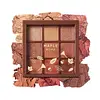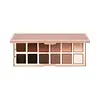What's inside
What's inside
 Key Ingredients
Key Ingredients

 Benefits
Benefits

 Concerns
Concerns

 Ingredients Side-by-side
Ingredients Side-by-side

Talc
AbrasiveMica
Cosmetic ColorantPolymethyl Methacrylate
Silica
AbrasiveMagnesium Myristate
CI 77891
Cosmetic ColorantDiisostearyl Malate
EmollientCI 77492
Cosmetic ColorantPhenyl Trimethicone
Skin ConditioningHydrogenated Polydecene
EmollientZinc Stearate
Cosmetic ColorantOctyldodecyl Stearoyl Stearate
EmollientCI 77491
Cosmetic ColorantCI 77499
Cosmetic Colorant1,2-Hexanediol
Skin ConditioningGlyceryl Caprylate
EmollientTriethoxycaprylylsilane
Aluminum Hydroxide
EmollientDimethicone
EmollientMethicone
EmollientBoron Nitride
AbsorbentNeopentyl Glycol Diethylhexanoate
EmollientCI 73360
Cosmetic ColorantDipentaerythrityl Hexahydroxystearate/Hexastearate/Hexarosinate
Skin ConditioningCI 19140
Cosmetic ColorantMagnesium Stearate
Cosmetic ColorantStearic Acid
CleansingSynthetic Fluorphlogopite
Rhus Succedanea Fruit Wax
Hydrogenated Castor Oil
EmollientTriethylhexanoin
MaskingSucrose Tetrastearate Triacetate
EmollientC10-30 Cholesterol/Lanosterol Esters
EmulsifyingSorbitan Sesquioleate
EmulsifyingPhenoxyethanol
PreservativeTocopherol
AntioxidantHydrogenated Polyisobutene
EmollientCalcium Aluminum Borosilicate
Nylon-12
Caprylic/Capric Triglyceride
MaskingDimethicone/Vinyl Dimethicone Crosspolymer
Skin ConditioningTin Oxide
AbrasiveDiphenylsiloxy Phenyl Trimethicone
Skin ConditioningPolypropylene
Dimer Dilinoleyl Dimer Dilinoleate
EmollientSynthetic Wax
AbrasiveWater
Skin ConditioningGlyceryl Polymethacrylate
Butylene Glycol
HumectantGlycerin
HumectantLithium Magnesium Sodium Silicate
AbsorbentAmmonium Acryloyldimethyltaurate/Vp Copolymer
Caprylyl Glycol
EmollientDisodium EDTA
Ethylhexylglycerin
Skin ConditioningAlcohol
AntimicrobialCamellia Sinensis Leaf Water
MaskingZingiber Officinale Root Extract
MaskingBiotin
AntiseborrhoeicTalc, Mica, Polymethyl Methacrylate, Silica, Magnesium Myristate, CI 77891, Diisostearyl Malate, CI 77492, Phenyl Trimethicone, Hydrogenated Polydecene, Zinc Stearate, Octyldodecyl Stearoyl Stearate, CI 77491, CI 77499, 1,2-Hexanediol, Glyceryl Caprylate, Triethoxycaprylylsilane, Aluminum Hydroxide, Dimethicone, Methicone, Boron Nitride, Neopentyl Glycol Diethylhexanoate, CI 73360, Dipentaerythrityl Hexahydroxystearate/Hexastearate/Hexarosinate, CI 19140, Magnesium Stearate, Stearic Acid, Synthetic Fluorphlogopite, Rhus Succedanea Fruit Wax, Hydrogenated Castor Oil, Triethylhexanoin, Sucrose Tetrastearate Triacetate, C10-30 Cholesterol/Lanosterol Esters, Sorbitan Sesquioleate, Phenoxyethanol, Tocopherol, Hydrogenated Polyisobutene, Calcium Aluminum Borosilicate, Nylon-12, Caprylic/Capric Triglyceride, Dimethicone/Vinyl Dimethicone Crosspolymer, Tin Oxide, Diphenylsiloxy Phenyl Trimethicone, Polypropylene, Dimer Dilinoleyl Dimer Dilinoleate, Synthetic Wax, Water, Glyceryl Polymethacrylate, Butylene Glycol, Glycerin, Lithium Magnesium Sodium Silicate, Ammonium Acryloyldimethyltaurate/Vp Copolymer, Caprylyl Glycol, Disodium EDTA, Ethylhexylglycerin, Alcohol, Camellia Sinensis Leaf Water, Zingiber Officinale Root Extract, Biotin
Pentaerythrityl Tetraisostearate
EmollientPPG-3 Benzyl Ether Ethylhexanoate
EmollientC15-19 Alkane
SolventPolyethylene
AbrasiveSilica
AbrasiveUndecane
EmollientNylon-12
Isononyl Isononanoate
EmollientTridecane
PerfumingVp/Eicosene Copolymer
Polyglyceryl-2 Dipolyhydroxystearate
Skin ConditioningPentaerythrityl Tetra-Di-T-Butyl Hydroxyhydrocinnamate
AntioxidantPolyglyceryl-3 Diisostearate
EmulsifyingTocopherol
AntioxidantHelianthus Annuus Seed Oil
EmollientCI 77492
Cosmetic ColorantCI 77491
Cosmetic ColorantCI 77499
Cosmetic ColorantSynthetic Fluorphlogopite
Mica
Cosmetic ColorantCalcium Silicate
AbsorbentOctyldodecyl Stearoyl Stearate
EmollientPolymethyl Methacrylate
Butyrospermum Parkii Butter
Skin ConditioningPhenoxyethanol
PreservativeOctyldodecanol
EmollientGlyceryl Triacetyl Ricinoleate
EmollientMagnesium Myristate
Trimyristin
Skin ConditioningPotassium Sorbate
PreservativeCaprylic/Capric Triglyceride
MaskingHydrogenated Lecithin
EmulsifyingPolyurethane-79
Iron Oxides
CI 77891
Cosmetic ColorantCI 77007
Cosmetic ColorantCetyl Ethylhexanoate
EmollientRicinus Communis Seed Oil
MaskingIsostearyl Neopentanoate
EmollientHydrogenated Styrene/Methylstyrene/Indene Copolymer
Copernicia Cerifera Wax
Zinc Stearate
Cosmetic ColorantCI 77163
Cosmetic ColorantPentaerythrityl Tetraisostearate, PPG-3 Benzyl Ether Ethylhexanoate, C15-19 Alkane, Polyethylene, Silica, Undecane, Nylon-12, Isononyl Isononanoate, Tridecane, Vp/Eicosene Copolymer, Polyglyceryl-2 Dipolyhydroxystearate, Pentaerythrityl Tetra-Di-T-Butyl Hydroxyhydrocinnamate, Polyglyceryl-3 Diisostearate, Tocopherol, Helianthus Annuus Seed Oil, CI 77492, CI 77491, CI 77499, Synthetic Fluorphlogopite, Mica, Calcium Silicate, Octyldodecyl Stearoyl Stearate, Polymethyl Methacrylate, Butyrospermum Parkii Butter, Phenoxyethanol, Octyldodecanol, Glyceryl Triacetyl Ricinoleate, Magnesium Myristate, Trimyristin, Potassium Sorbate, Caprylic/Capric Triglyceride, Hydrogenated Lecithin, Polyurethane-79, Iron Oxides, CI 77891, CI 77007, Cetyl Ethylhexanoate, Ricinus Communis Seed Oil, Isostearyl Neopentanoate, Hydrogenated Styrene/Methylstyrene/Indene Copolymer, Copernicia Cerifera Wax, Zinc Stearate, CI 77163
Ingredients Explained
These ingredients are found in both products.
Ingredients higher up in an ingredient list are typically present in a larger amount.
This ingredient is an emollient, solvent, and texture enhancer. It is considered a skin-softener by helping the skin prevent moisture loss.
It helps thicken a product's formula and makes it easier to spread by dissolving clumping compounds.
Caprylic Triglyceride is made by combining glycerin with coconut oil, forming a clear liquid.
While there is an assumption Caprylic Triglyceride can clog pores due to it being derived from coconut oil, there is no research supporting this.
Learn more about Caprylic/Capric TriglycerideCi 77491 is also hydrated iron III oxide. It's sole purpose is to give a red/pink hue to products.
Iron III oxides are classified as inorganic chemicals for coloring.
Synthetically created Ci 77491 is considered safer than those naturally found. This is because the synthetically created version may contain less impurities. Iron oxides are generally non-toxic and non-allergenic.
Learn more about CI 77491Ci 77492 is also hydrated iron III oxide. It's sole purpose is to give a yellow hue to products.
Iron III oxides are classified as inorganic chemicals for coloring.
Synthetically created Ci 77492 is considered safer than those naturally found. This is because the synthetically created version may contain less impurities. Iron oxides are generally non-toxic and non-allergenic.
Learn more about CI 77492Ci 77499 is also hydrated iron III oxide. It is created from mixing red and black iron oxides. This helps give shades of darkness to a product.
Iron III oxides are classified as inorganic chemicals for coloring.
Ci 77891 is a white pigment from Titanium dioxide. It is naturally found in minerals such as rutile and ilmenite.
It's main function is to add a white color to cosmetics. It can also be mixed with other colors to create different shades.
Ci 77891 is commonly found in sunscreens due to its ability to block UV rays.
Learn more about CI 77891We don't have a description for Magnesium Myristate yet.
Mica is a naturally occurring mineral used to add shimmer and color in cosmetics. It can also help improve the texture of a product or give it an opaque, white/silver color.
Serecite is the name for very fine but ragged grains of mica.
This ingredient is often coated with metal oxides like titanium dioxide. Trace amounts of heavy metals may be found in mica, but these metals are not harmful in our personal products.
Mica has been used since prehistoric times throughout the world. Ancient Egyptian, Indian, Greek, Roman, Aztec, and Chinese civilizations have used mica.
Learn more about MicaNylon-12 is a polymer. It is derived from 12-aminododecanoic acid, an omega-amino fatty acid
According to a manufacturer, it is a talc substitute. Like talc, nylon-12 gives products a satin feel. The manufacturer also claims this ingredients does not block pores and has moderate oil absorption.
This ingredient may not be reef-safe.
Learn more about Nylon-12Octyldodecyl Stearoyl Stearate is created from stearic acid.
It is an emollient and thickens the lipid (oil) portion of a product. Due to its emollient properties, it may not be fungal-acne safe.
Phenoxyethanol is a preservative that has germicide, antimicrobial, and aromatic properties. Studies show that phenoxyethanol can prevent microbial growth. By itself, it has a scent that is similar to that of a rose.
It's often used in formulations along with Caprylyl Glycol to preserve the shelf life of products.
This ingredient is also known as PMMA. It is a polymer microsphere, composed of tiny, perfectly spherical particles formed from repeating units.
In cosmetics, PMMA is mainly used to give a soft or blurring effect. The transparent particles are able to scatter light and help reduce the appearance of fine-lines and imperfections.
PMMA is also able to enhance the texture of products by add a smooth feel.
Learn more about Polymethyl MethacrylateSilica, also known as silicon dioxide, is a naturally occurring mineral. It is used as a fine, spherical, and porous powder in cosmetics.
Though it has exfoliant properties, the function of silica varies depending on the product.
The unique structure of silica enhances the spreadability and adds smoothness, making it a great texture enhancer.
It is also used as an active carrier, emulsifier, and mattifier due to its ability to absorb excess oil.
In some products, tiny microneedles called spicules are made from silica or hydrolyzed sponge. When you rub them in, they lightly polish away dead skin layers and enhance the penetration of active ingredients.
Learn more about SilicaSynthetic Fluorphlogopite is the synthethic version of mica. It consists of fluorine, aluminum and silicate.
Synthetic Fluorphlogopite is used to add volume to products.
It is considered non-irritating on the skin.
Learn more about Synthetic FluorphlogopiteTocopherol (also known as Vitamin E) is a common antioxidant used to help protect the skin from free-radicals and strengthen the skin barrier. It's also fat soluble - this means our skin is great at absorbing it.
Vitamin E also helps keep your natural skin lipids healthy. Your lipid skin barrier naturally consists of lipids, ceramides, and fatty acids. Vitamin E offers extra protection for your skin’s lipid barrier, keeping your skin healthy and nourished.
Another benefit is a bit of UV protection. Vitamin E helps reduce the damage caused by UVB rays. (It should not replace your sunscreen). Combining it with Vitamin C can decrease sunburned cells and hyperpigmentation after UV exposure.
You might have noticed Vitamin E + C often paired together. This is because it is great at stabilizing Vitamin C. Using the two together helps increase the effectiveness of both ingredients.
There are often claims that Vitamin E can reduce/prevent scarring, but these claims haven't been confirmed by scientific research.
Learn more about TocopherolZinc Stearate is the metal salt of stearic acid. It is a white solid used to bind, thicken, and lubricate products.
This ingredient is common in powder makeup, where it helps keep the powder together.
Zinc Stearate is hydrophobic and repels water.
This ingredient can be sourced from non-animal or animal sources. It is best to reach out to the brand to see where they source this ingredient from.
Learn more about Zinc Stearate